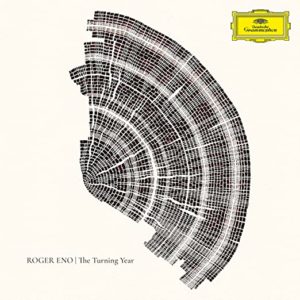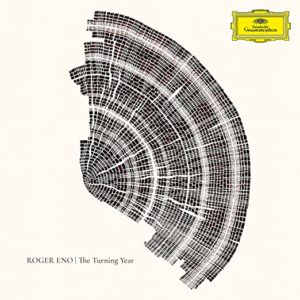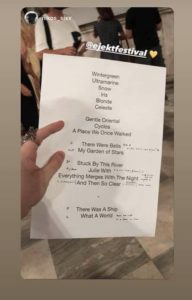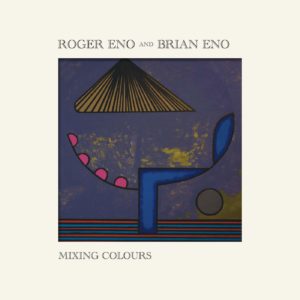Der erste Eindruck des Albums „Mixing Colours“ von Roger und Brian Eno wäre überraschend gewesen, hätte ich nicht die Vorab-Veröffentlichungen für die Klanghorizonte gekannt, denn kompositorisch-stilistisch ist das erstaunlich rückblickend, bezogen auf die Harmonik (du erinnerst dich bestimmt an deinen Musikunterricht: Tonika, Subdominante, Dominante, Funktionsharmonik, verminderter Septakkord usw.) („nein, nur sehr flüchtig“; M.E.)
Melodik und auch Form haben mich positiv überrascht, weil die Miniaturen nicht „amöbenhaft“ formlos gestaltet sind. Jedes der kurzen Stücke entwickelt sich aus charakteristischen Ingredienzien, hat klare Konturen.
18 kurze Stücke, zwar untereinander keine großen Kontraste aufweisend, aber doch jedes von eigenem Charakter. Nun gibt es (vor allem in der Klaviermusik des 19. Jhs.) den Typus des „Charakterstücks“. Der Einfachheit halber zitiere ich aus Wikipedia:
„Ein Charakterstück, lyrisches Stück oder Genrestück ist ein kürzeres Musikstück vor allem für das Klavier. Es soll eine Stimmung ausdrücken, die zumeist mit einem Titel umschrieben wird.“
Roger vergibt ebenfalls Titel, die wohl aus der englischen Farbwörter-Truhe stammen, jedoch offener sind als z.B. „Verrufene Stelle“ (Robert Schumann, in den „Waldszenen“ op. 82).
Er sagt im Interview:
I like the idea of having names of colours that you don’t have to associate a phrase like “the old road” or something like this with. You know, that you then focus on and that would be your mental vision. When you have the name of a colour, you have a kind of atmosphere, but it’s a non-specific atmosphere.
Ich habe einen Zyklus mit 24 Stücken assoziiert, nämlich F. Chopins Préludes op. 28, die ich dir wärmstens zum Anhören empfehle. Das sind Miniaturen vom Typus des „Charakterstücks“, wenngleich sie ganz neutral „Préludes“ heißen. Sie sind allerdings von höchstem Kontrastreichtum – ganz im Gegensatz zu Rogers schmaler Bandbreite an Stimmungen und kompositorisch von ganz anderem Kaliber.
Auf Komponisten der Romantik rekurrieren ja Víkingur und Roger, wobei Víkingur mit Schumann ziemlich daneben liegt, wie auch Roger korrigierend anmerkt: … like definite harmonic influences, melodic like Schubert I’d say actually, more than Schumann … Von Chopin spricht Roger NICHT in Bezug auf stilistische Anleihen, sondern auf die magische Stunde der sprudelnden Kreativität: … Put my equipment on and improvise, before you completely wake up it’s quite a good time for that. You know, you’re talking about Chopin, that’s his “opium hours”. That was quite a good time for me. …
Meine minimale Voreingenommenheit habe ich schnell abgelegt, zumal mir Benedicte Maurseth zuflog. Mit ihrer Musik und ihrem Buch „To Be Nothing“ beschäftige ich mich zur Zeit sehr intensiv. Dieser wunderbaren Musik aus Hardanger gegenüber bin ich überhaupt nicht voreingenommen, sie ergreift mich unmittelbar mit ihrer überwältigenden Schönheit. Dabei ist sie nüchtern betrachtet der Musik Roger Enos formal sehr ähnlich. Es sind Tänze & Hörstücke, die eine charakteristische, meist einheitliche Stimmung ausstrahlen, aus einem charakteristischen musikalischen Motiv entwickelt werden, wobei variierte Wiederholung eine Rolle spielt.
Rogers Album ist stilistisch dem 19. Jahrhundert verpflichtet, natürlich auch der charmanten Simplizität Erik Saties, ABER die Sounds sind es NICHT. Deswegen ist mir die Anmerkung what is old is new, and what is new is old aus dem Booklet zu ihrem (und Knut Hamres) Album Anima eingefallen, diese Haltung, aus Tradition, aus Altem in Neuland vorzudringen, im Neuen die Bindung an Vergangenes zu bewahren. That’s Life.
Ich empfehle Benedictes bei ECM erschienenes Album Over Tones, auf dem Maurseth sowohl traditionelle Hardangermusik und Eigenkompositionen auf dem alterwürdigen Instrument Hardingfele spielt.
Ich habe mir zu jedem Stück Notizen gemacht, verzichte aber darauf, sie zu zitieren. Mir ist dabei aufgefallen, dass 3 Stücke über der gleichen Basslinie sich entfalten. Nach der Lesung des Interviews wurde bestätigt, dass es 3 Soundvarianten des gleichen MIDI-Files sind, also auch die Melodien identisch sind. OK, wäre mir nach weiteren Hör-Durchgängen sicher aufgefallen.
Brian So for instance, on the album there are three tracks that all use the same original MIDI performance.
Víkingur SPRING FROST, VERDIGRIS and CERULEAN BLUE
Auffällig ist, dass die meisten Stücke im 3/4- bzw 6/4-Takte stehen. Es gibt ein paar Stücke, die es mir besonders angetan haben:
04 – Wintergreen
05 – Obsidian / flächig fließend, Puls vermeidend
07 – Dark Sienna
09 – Snow / teilweise melodisch polyphon wirkend
10 – Rose Quartz
11 – Quicksilver / metrisch angenehm verwirrend
15 – Desert Sand / reizvolle Sound-Kontraste
16 – Deep Saffron
Lektüre nach 2-maligem Anhören des Albums
sehr interessante Passage:
Brian In fact, what’s interesting is when you are in both of those places, the past and the future. What has happened in the last 50 years of electronic music is that there’s been a huge emphasis – exploited almost entirely by pop music and hardly at all by classical music – on the new possibilities of instrument colour, timbre. If you think about classical music and you think that the clarinet represents this tiny little oasis of sound and the viola is another thing and the piano is another, but nonetheless there (ich ziehe das Wort THEY vor, es bezieht sich dann auf die Sounds herkömmlicher Instrumente) are little islands in the world of all the possible sounds that you could make. What’s happened with electronics is that all those spaces in between have been filled in with new sounds that never existed before, and lots of others that nobody even imagined. So suddenly there’s all of this huge palette of colours. It’s a little bit like if, from say the 1950s onwards, there had suddenly come into existence thousands and thousands of new paint colours. Can you imagine it that you go down to the paint shop and there’s a colour you’ve never seen before. Doesn’t have a name. It doesn’t look like anything else, sort of browny, pinky, greeny, bluey. There’s no name for it, you know. So, really, it’s only in pop music that that has been recognised, that the material of contemporary music more than anything else is timbre. It’s not really melody. It’s not really structures. It is beats.
Dem stimme ich im Großen und Ganzen zu. Aber schon vor dem Einzug der Elektronik in die Musik – beginnend in den 50er Jahren (Stockhausen, Studio für Elektronische Musik des WDR bzw. NWDR, aber auch andere in USA & Europa) – gab es in der Klassischen Musik die „Arbeit“ am Sound. Ich empfehle dazu:
Heinrich Ignaz Franz Biber, Battalia
Hector Berlioz, Symphonie fantastique
(übrigens das erste Stück Drogenrausch-Musik der Geschichte)



